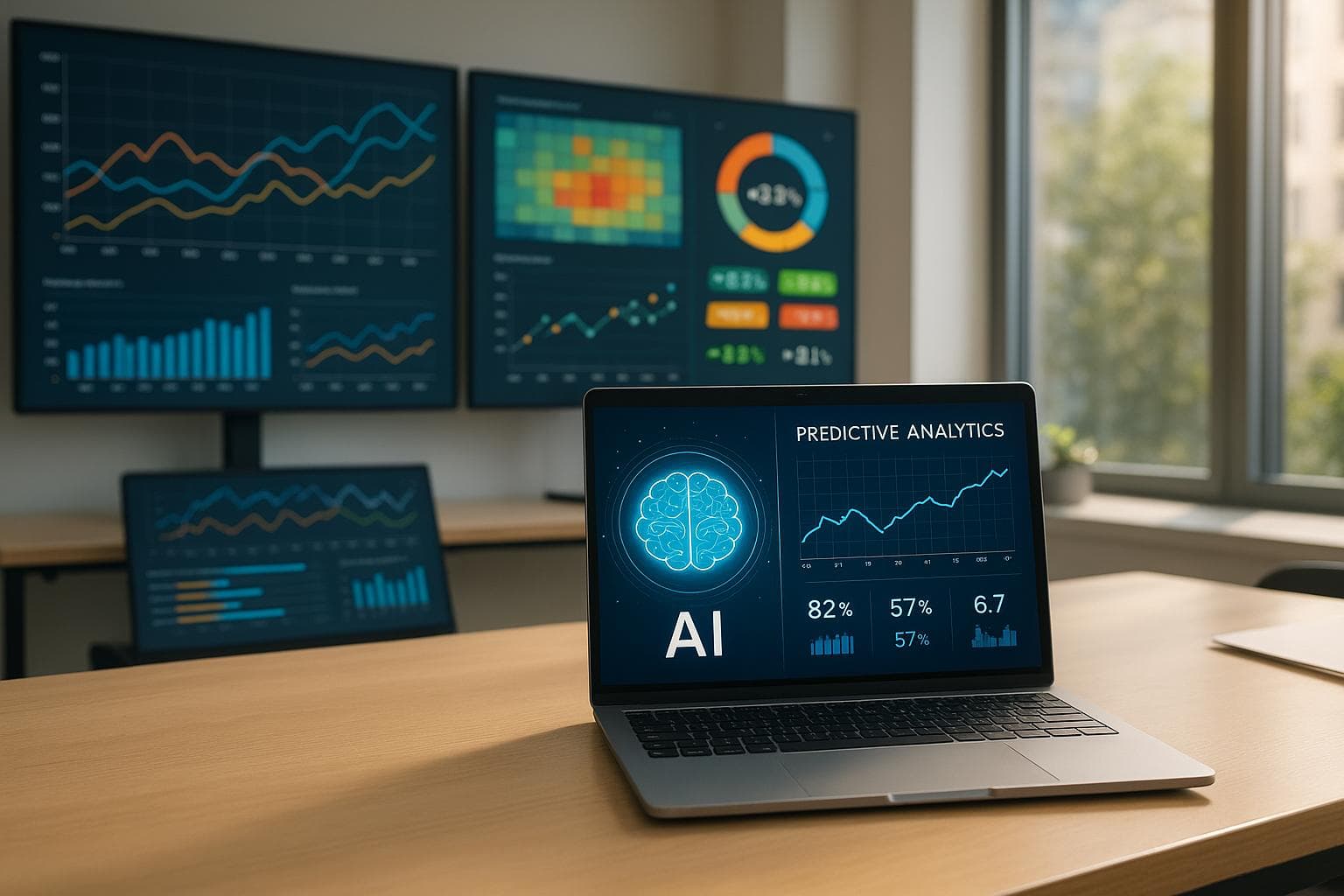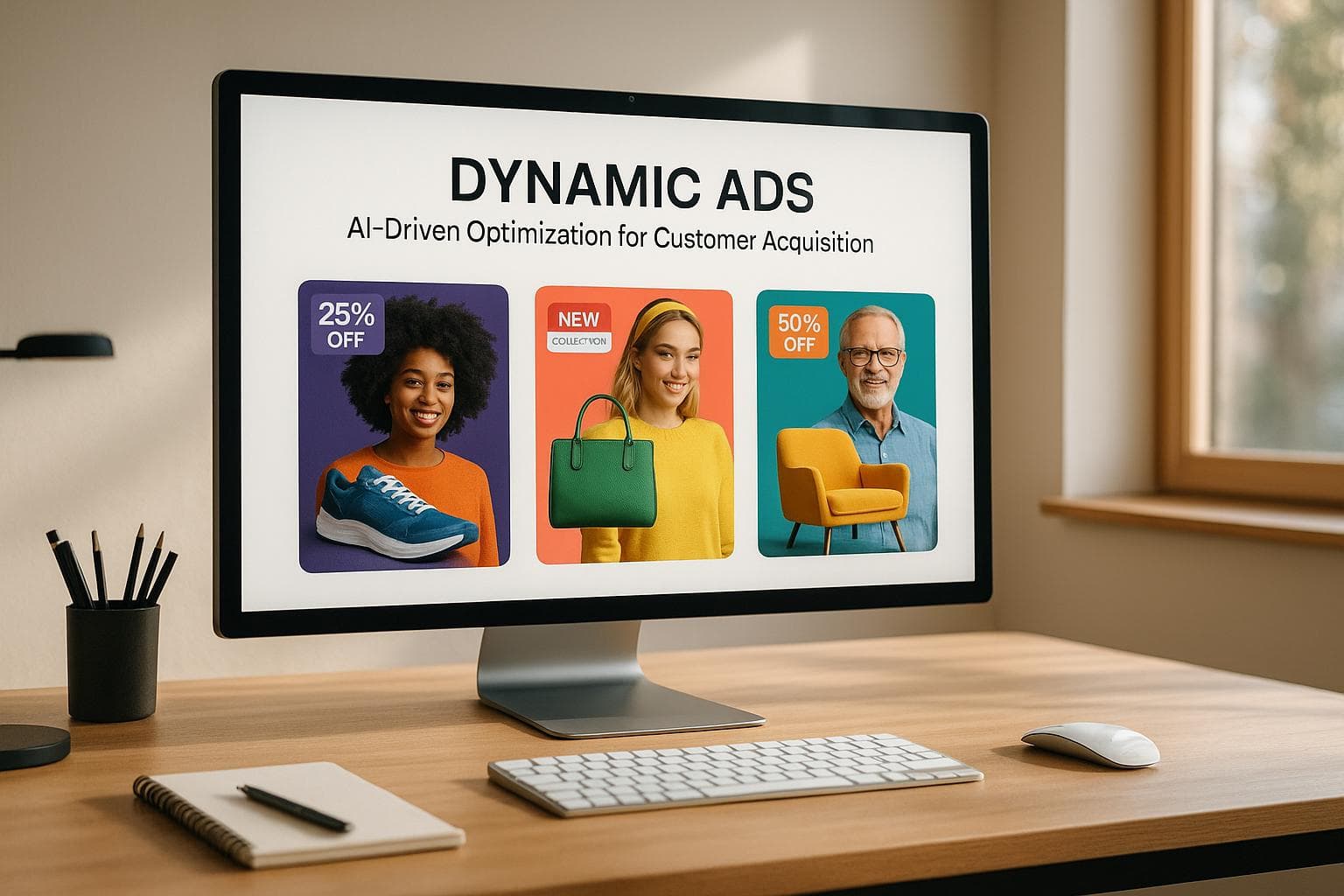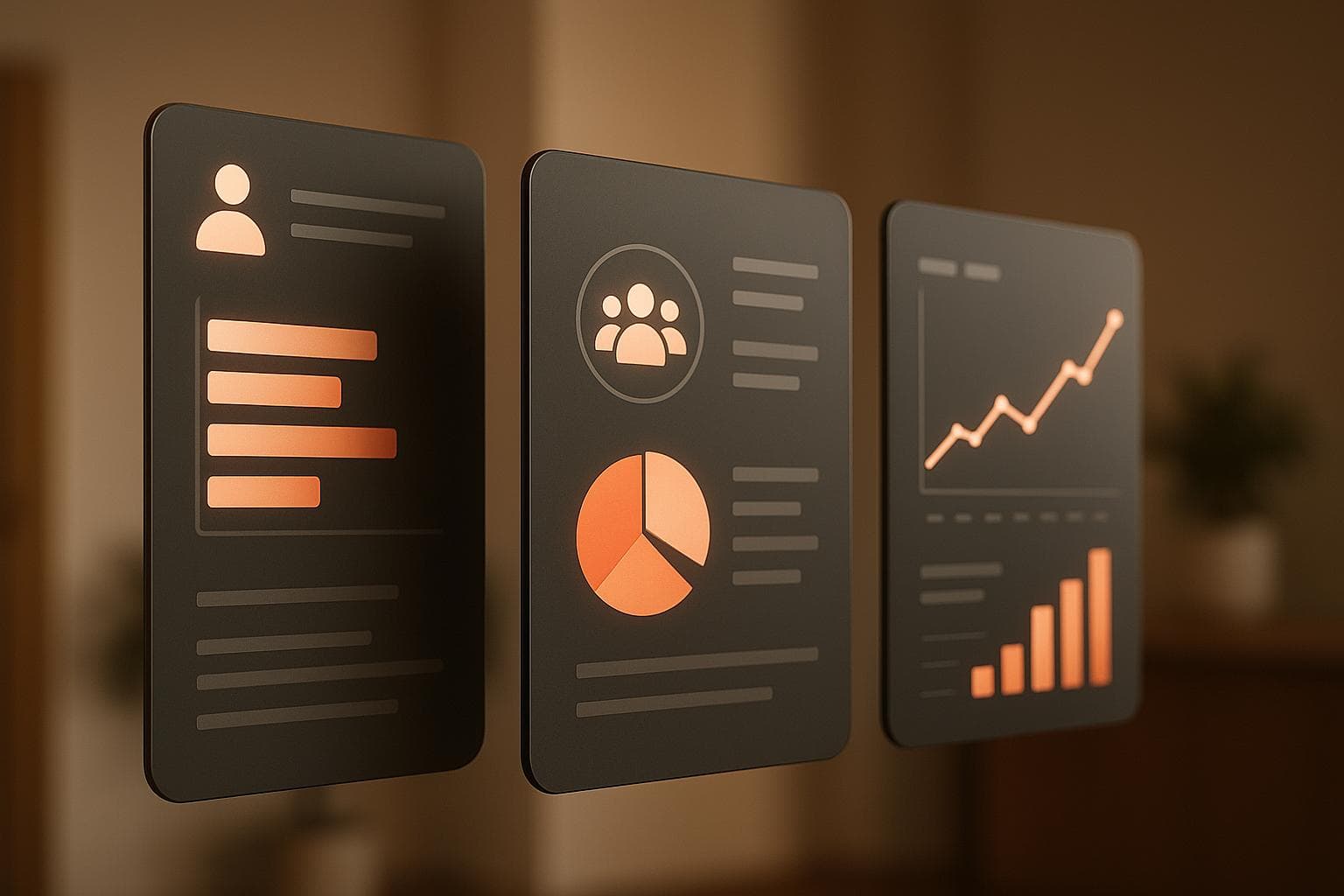ROI Comparison: Manual vs Automated Ad Management
AI-driven ad management outperforms manual methods, enhancing ROI and efficiency while reducing costs and errors.
Manual vs. Automated Ad Management: Which delivers better ROI?
If you're managing ad campaigns, here's the bottom line: AI-powered automation consistently outperforms manual methods in ROI, efficiency, and scalability.
Key Takeaways:
Manual Management:
Average ROAS falls short (e.g., Google Ads: 3.75:1 vs. 5:1 industry benchmark).
Time-consuming: 60% of time spent on repetitive tasks.
High operational costs and error rates.
AI-Powered Automation:
Cuts cost per acquisition by 20–30%.
Saves 90% of campaign setup time.
Boosts lead conversion rates by 30% and ROI by up to 12%.
Quick Comparison:
| Metric | Manual | Automated | Impact |
|---|---|---|---|
| Cost Per Acquisition | Baseline | 20–30% reduction | Lower costs |
| Campaign Setup Time | 60–90 minutes | 5 minutes | 90% faster |
| Lead Conversion Rate | Baseline | 30% increase | Higher sales |
| Operational Costs | High | 32% reduction | Significant savings |
| Error Rates | Higher | Minimal | Improved accuracy |
Why it matters: Manual processes are slow, costly, and prone to errors. Automation not only saves time and money but also drives better performance across platforms, making it the smarter choice for scaling campaigns effectively.
How Do Improved Conversion Rates From Automation Affect ROI? - Marketing and Advertising Guru
1. Manual Campaign Management
Managing campaigns manually can be a real hurdle for e-commerce businesses aiming to boost ROI and efficiency. Take a look at the average ROAS (Return on Ad Spend) values below - they consistently fall short of the industry benchmark of 5:1, which signals solid performance. Hitting a 10:1 ratio is considered outstanding [1].
| Platform | Average ROAS |
|---|---|
| Google Ads | 3.75:1 |
| Facebook Ads | 3.25:1 |
| PPC/SEM | 2.05:1 |
On top of that, teams spend more than an hour daily on repetitive tasks like setting up search campaigns. This inefficiency results in 77% of inbound leads being ignored [2][3]. Such delays and missed opportunities make scalability and quick responses to market changes difficult.
Manual management also requires constant human oversight, which drives up operational costs and increases the chances of errors. Plus, it slows down the ability to adapt when the market shifts [4]. To make matters worse, if leads aren’t followed up within five minutes, the likelihood of converting them drops dramatically [3].
The competitive gap becomes even more apparent as consumer behavior evolves. For example, 71% of online shoppers now start their product searches on Amazon [4]. This trend highlights how manual processes can drag down ROI, making it clear that businesses need smarter ways to manage their campaigns.
2. AI-Powered Campaign Management
AI-powered campaign management offers a game-changing alternative to manual methods, which often struggle to scale effectively. The results speak for themselves: automation delivers measurable improvements that directly impact ROI.
For example, data reveals that automated bidding can reduce cost per acquisition by 20–30% [7]. Similarly, finance teams spend an average of 520 hours annually on manual tasks, costing $36,190 in median salaries and leading to error rates as high as 4%. Automation not only cuts these costs but also minimizes errors [8][9].
A 2024 case study highlights the time and cost savings AI can provide. Automation reduced campaign setup time from 60–90 minutes to just 5 minutes per account, slashed cost per thousand impressions by 65%, and saved 1,300 hours overall [13].
The benefits of AI-powered management are evident across several key metrics:
| Performance Metric | Impact |
|---|---|
| Lead Conversion | 30% increase [10] |
| Budget Utilization | Improved from 95% to 98% [13] |
| Operational Costs | 32% reduction [12] |
| Campaign Setup Time | 90% reduction [13] |
Industry leaders also emphasize the transformative potential of AI in campaign management.
"AI is fundamentally changing how we build, test, and optimize advertising campaigns", says Anny Zhang, Product Marketing Manager for Small and Medium Businesses and Growth at Microsoft Advertising [6].
AI-powered systems excel in areas where manual tasks often fall short. They handle real-time bid adjustments, dynamic ad optimization across multiple channels, automated audience segmentation, and predictive budget allocation with ease. Unlike manual processes, which often struggle as campaign complexity grows, automated systems scale efficiently while maintaining quality and performance [11].
"AI is only as good as the data it has to learn from. To optimize your ad campaigns for the largest possible ROI, sync your first-party data, including customer and lead lists, into each ad platform", advises Kayla Johansen, PPC Analyst at WebFX [5].
These advancements particularly shine in multi-channel campaigns. Automation ensures consistent messaging, optimizes performance across platforms, and improves budget efficiency. Brands leveraging AI-powered campaign management have seen up to 1.7x higher click-through rates, proving its effectiveness in driving results [6].
sbb-itb-0bd1697
Direct Comparison Results
Looking at the data on manual versus AI-powered strategies, the numbers paint a clear picture: automated ad management consistently outperforms manual methods in both efficiency and cost savings.
Key Performance Metrics
| Metric | Manual Management | Automated Management | Impact |
|---|---|---|---|
| Cost Per Acquisition | Baseline | 20–30% reduction [7] | Noticeable cost savings |
| Order Management Efficiency | Baseline | 75% improvement [16] | Streamlined workflows |
| Media Planning Speed | Standard process | 90% faster execution [16] | Quick campaign launches |
| Administrative Tasks | 60% of time spent [16] | Up to 90% reduction [15] | Time freed for strategy |
| Revenue Impact | Baseline | Up to 12% increase [16] | Boosted profitability |
Manual processes often require constant adjustments, making them less scalable and more expensive. In contrast, automated systems process data in real time, enabling instant optimizations. This becomes even more critical as campaigns grow more complex.
For organizations relying on manual workflows, skilled professionals often spend 60% of their time on routine, non-strategic tasks [16]. Automating these tasks allows teams to redirect their energy toward strategic planning and creative initiatives.
Operational Advantages of Automation
65% reduction in reporting time [16]
75% improvement in order management efficiency [16]
Lower error rates across workflows
Smarter budget allocation and utilization
AI-powered systems not only cut costs but also increase ROI by up to 12% within the first year [16]. These gains come from a combination of reduced expenses and better performance across multiple channels.
Unlike manual processes, which are prone to errors that can snowball, automated systems ensure consistent performance, no matter the size or complexity of the campaign. This consistency is key to scaling operations and maximizing returns on ad spend.
"The issues with Facebook ad management and the ability to fine-tune and optimize ad performance lie greatly in the fact that it is a manual process for many business owners and marketers, require a large time investment, and can be rather complex for businesses that have the goal of achieving high ROI."
- Loni Loo [14]
The data highlights how automated ad management not only scales performance but also drives better ROI, making it an essential tool for businesses aiming to grow efficiently.
Conclusion
The numbers speak for themselves: AI-driven ad management consistently outperforms manual methods when it comes to ROI. For businesses reassessing their ad strategies, focusing on clear goals, automating repetitive tasks, and keeping human oversight in the mix are essential steps toward success.
Take Solly Baby, for example - they slashed their cost-per-acquisition by 50% after transitioning from manual to automated ad targeting[17].
Here are some practical steps to consider:
Set Clear Objectives: Establish measurable performance targets and define triggers for scaling campaigns before diving into automation[18].
Ease into Automation: Start by automating simpler tasks like bid adjustments and budget management to test the waters[19].
Keep Humans in the Loop: Automation can handle the bulk of the work, but human expertise is key for refining strategies, ensuring accuracy, and driving ongoing improvements[19].
Kaitlyn Kerr, Social Media Manager at Agital, sums it up perfectly:
"ASC+ has cut cost-per-acquisition by up to 32% for some of our clients. It's about balancing automation with a solid creative and audience strategy. Automation can optimize campaigns, but success depends on feeding it the right inputs - compelling visuals, clear messaging, and a deep understanding of your audience."
- Kaitlyn Kerr, Social Media Manager at Agital[17]
The evidence is clear - automation not only streamlines ad management but also delivers measurable results, making it a smart choice for businesses aiming to scale efficiently and maximize ROI.
FAQs
How does AI-powered ad management boost ROI compared to managing ads manually?
AI-driven ad management transforms how businesses handle campaigns, using advanced algorithms to make real-time optimizations. Unlike manual approaches, these systems continuously analyze performance metrics, tweaking bids and refining targeting to make every dollar count. The result? Smarter ad placements, better click-through rates, and more conversions.
Take this for example: AI can quickly adapt to shifting market trends and user behaviors, helping you get the most out of your return on ad spend (ROAS) while cutting down on wasted spending. Plus, automation eliminates common human mistakes and frees up your time to focus on big-picture strategies and scaling efforts. Many companies have seen their ROI jump by as much as 30% after adopting AI-powered ad management tools.
What are the first steps for switching from manual to automated ad management?
To move from manual to automated ad management effectively, start by taking a close look at your current workflows. Pinpoint where things slow down, identify repetitive tasks, and find areas where automation could save time or boost results. It’s also a good idea to get your team’s input - they can help highlight obstacles and spot opportunities you might miss.
Once you’ve done that, establish specific goals for automation. Whether you’re aiming to streamline processes, cut costs, or scale up your ad campaigns, having clear objectives will guide your decisions. Select an automation tool that fits your business requirements and offers the flexibility to support your advertising goals.
Instead of diving in all at once, opt for a phased rollout. Test the system in smaller stages, using performance metrics and team feedback to make adjustments along the way. This step-by-step approach not only minimizes disruptions but also helps you get the most out of your investment.
How can businesses keep their automated ad campaigns effective and aligned with their marketing goals?
To keep automated ad campaigns effective and aligned with marketing goals, businesses should begin by setting specific objectives and defining measurable key performance indicators (KPIs). These benchmarks act as a roadmap, helping track progress and identify areas for improvement.
It’s also crucial to regularly analyze campaign performance using data analytics. This approach enables businesses to make smart, data-driven decisions and fine-tune strategies based on real-time insights. Incorporating audience segmentation and personalization into campaigns ensures ads connect with the right customer groups, driving better engagement and boosting conversion rates.
Another powerful tool is A/B testing, which can reveal which campaign elements work best. By consistently refining strategies based on these findings, businesses can stay on track with their goals and get the most out of their advertising budgets.
Geoffrey G.










